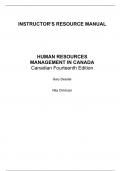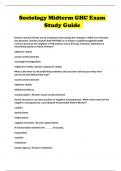INSTRUCTOR’S RESOURCE MANUAL
HUMAN RESOURCES
MANAGEMENT IN CANADA
Canadian Fourteenth Edition
Gary Dessler
Nita Chhinzer
, PART ONE: HUMAN RESOURCES MANAGEMENT IN PERSPECTIVE
CHAPTER 1
THE STRATEGIC ROLE OF HUMAN RESOURCES MANAGEMENT
LEARNING OBJECTIVES
1.1 Define human resources management and analyze how it relates to the management
process.
1.2 Describe the value of HR expertise to non-HR managers and entrepreneurs.
1.3 Explain how HRM has changed over recent years to include a higher-level advisory role.
1.4 Identify tools to help make evidence-based HRM decisions.
1.5 Describe the core HR competencies and professionalism of the HRM function.
1.6 Discuss the internal and external environmental factors affecting human resources
management policies and practices, and explain their impact.
CHAPTER SUMMARY
This chapter focuses on the strategic role of HRM and HR professionals in today’s business
context. Strategic HRM links the management of people to strategic goals and objectives to
improve business performance. Specific roles of HR professionals illustrate the new partnership
between HRM and organizational managers and executives. Specific areas of HR activity,
operational and strategic, show how HRM has gone beyond its traditional administrative role.
The chapter also considers that many employers are changing how they organize their human
resource functions. The chapter looks at the professional designations in Canada. The chapter
concludes with a look at the external factors that impact HRM, including economic factors,
labour market issues, technology, government, globalization, and environmental concerns, as
well as internal environment influences.
LECTURE OUTLINE
Where Are We Now . . .
The purpose of this chapter is to explain what human resources management (HRM) is, and
why it’s important to all managers. We’ll see that human resources management activities—
such as hiring, training, appraising, compensating, and developing employees—are part of
every manager’s job. And we’ll see that human resources management is also a separate
function, usually with its own human resource or HR manager.
Copyright © 2020 Pearson Canada Inc.
,Chapter 1 – The Strategic Role of Human Resources Management 1-2
I. THE STRATEGIC ROLE OF HUMAN RESOURCES MANAGEMENT
Learning Objective 1.1 Define human resources management and analyze how it relates
to the management process.
Learning Objective 1.2 Describe the value of HR expertise to non-HR managers and
entrepreneurs.
1. What do managers do?
• Organization – consists of people with assigned roles who work together to achieve
organization’s goals.
• Managers are responsible for managing efforts of people to achieve organization’s
goals.
• Managing involves planning, organizing, staffing, leading, and controlling – that is the
management process.
2. Human resources management is the management of people in organizations:
• Attracting, retaining, and engaging the diverse talent required to meet operational
and performance commitments made to customers and shareholders.
‒ Find and hire the best individuals available.
‒ Develop their talent.
‒ Create a productive work environment.
‒ Continually build and monitor the workforce.
3. HRM involves formulating and implementing HR systems (e.g. recruitment,
performance appraisal, and compensation) that are aligned with organizational strategy
(see Figure 1.1). This ensures that necessary competencies and behaviours will be
available to meet strategic goals.
A. Strategy and Human Capital
1. Strategic plan is the company’s overall plan for how it will match internal strengths
and weaknesses with external opportunities and threats in order to maintain a
competitive advantage.
2. Strategy is a course of action the company pursues to achieve its strategic aims.
3. Strategic management is the process of identifying and executing the
organization’s strategic plan.
• Company’s policies and practices support strategic goals.
4. Human capital is the knowledge, education, training, skills and expertise of the
workforce.
• Knowledge-based economy depends on acquisition and development of superior
human capital.
Research has shown that strategically aligned systems of HR practices are related to
better organizational performance and competitive advantage. The resource-based view
of the firm suggests that HR practices contribute to the development of embedded
knowledge of a firm’s culture, history, processes, and context, which are non-imitable
(hard to copy by competitors).
Copyright © 2020 Pearson Canada Inc.
, Chapter 1 – The Strategic Role of Human Resources Management 1-3
Three specific HR practices (profit sharing, results-oriented performance appraisal, and
employment security) are strongly related to accounting measures of firm performance,
such as return on assets and return on equity. A more extensive set of practices, known
collectively as high-performance HR practices, have a positive relationship with turnover,
productivity, and corporate financial performance (gross rate of return on capital).
Teaching Tip: This is a critical section for getting buy-in from students in quantitative
disciplines/fields (e.g. economics, finance, accounting, and engineering) who may see
HR as more trivial and less important than their other courses. Have students guess how
much of a difference effective HR makes, then share the statistics and graphs from
empirical research. If using this text for an MBA class you can assign one or more
articles as class preparation.
B. Why Is Human Resources Management Important to All Managers?
Entrepreneurs, employees, HR managers, and all managers in small, medium, and large
businesses should be educated on human resources management to avoid mistakes in
hiring, managing employee performance, avoiding discriminatory, unfair, and unsafe
practices in organizational management and performance.
Mistakes managers don’t want to make:
• Hire the wrong person for a job
• Experience high turnover
• Have employees work below performance expectations
• Waste time with useless interviews
• Face legal problems because of discriminatory actions
• Break occupational safety laws for unsafe practices
• Set unfair salaries and compensation among employees
• Allow lack of training undermine department’s effectiveness
• Commit unfair labour practices.
HR is critical in wide variety of public and private sector organizations.
II. THE EVOLUTION OF HRM
Learning Objective 1.3 Explain how HRM has changed over recent years to include a
higher-level advisory role. Identify tools to help make evidence-based HRM decisions.
A. A Brief History of HRM
1. Thousands of years ago ancient armies attracted, selected, trained and motivated
workers.
2. Later 1800s in the post-Industrial Revolution set up “welfare offices” to manage
labour problems.
3. By 1900s the first “hiring offices” and training programs were the early stages of
personnel management.
4. In the 1930s union laws expanded the role of HR.
Copyright © 2020 Pearson Canada Inc.





